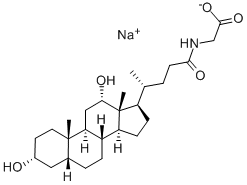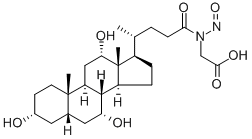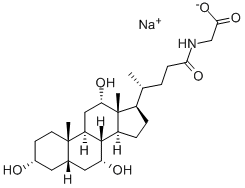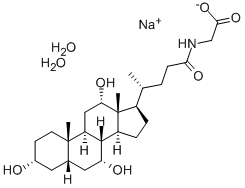GLYCODEOXYCHOLIC ACID SODIUM SALT
Synonym(s):3α,12α-Dihydroxy-5β-cholan-24-oic acid N-(carboxymethyl)amide;GDCA;Glycodeoxycholic acid sodium salt;Glycodesoxycholic acid;N-(3α,12α-Dihydroxy-24-oxocholan-24-yl)glycine
- CAS NO.:16409-34-0
- Empirical Formula: C26H42NNaO5
- Molecular Weight: 471.61
- MDL number: MFCD00036742
- EINECS: 240-455-4
- SAFETY DATA SHEET (SDS)
- Update Date: 2024-11-20 11:41:24

What is GLYCODEOXYCHOLIC ACID SODIUM SALT?
Physical properties
Solid
The Uses of GLYCODEOXYCHOLIC ACID SODIUM SALT
Sodium glycodeoxycholate has been used in a study to develop more similar mimetic intestinal fluids to physiological fluids than those developed by mixed bile salt systems (MBS). It has also been used in a study to investigate Ca2+ buffering capability of bile salt micelles.
What are the applications of Application
Glycodeoxycholic acid sodium salt is an activator of endonuclease-mediated apoptotis in hepatocytes
Definition
ChEBI: Sodium glycodeoxycholate is a bile acid salt that is the sodium salt of glycodeoxycholic acid. It has a role as a human metabolite. It is a bile acid salt and an organic sodium salt. It contains a glycodeoxycholate.
General Description
Sodium glycodeoxycholate is a bile salt that can be used to form biomimicking environments.
Biochem/physiol Actions
Induces apoptosis in hepatocytes; may induce DNA cleavage.
Properties of GLYCODEOXYCHOLIC ACID SODIUM SALT
| Melting point: | 245-250 °C |
| storage temp. | Inert atmosphere,2-8°C |
| solubility | H2O: 0.1 M at 20 °C, clear, colorless |
| form | White solid |
| color | White to Off-White |
| Stability: | Hygroscopic |
| CAS DataBase Reference | 16409-34-0 |
Safety information for GLYCODEOXYCHOLIC ACID SODIUM SALT
| Signal word | Warning |
| Pictogram(s) |
 Exclamation Mark Irritant GHS07 |
| GHS Hazard Statements |
H302:Acute toxicity,oral H312:Acute toxicity,dermal H332:Acute toxicity,inhalation |
| Precautionary Statement Codes |
P261:Avoid breathing dust/fume/gas/mist/vapours/spray. P264:Wash hands thoroughly after handling. P264:Wash skin thouroughly after handling. P270:Do not eat, drink or smoke when using this product. P271:Use only outdoors or in a well-ventilated area. P280:Wear protective gloves/protective clothing/eye protection/face protection. P330:Rinse mouth. P363:Wash contaminated clothing before reuse. P301+P312:IF SWALLOWED: call a POISON CENTER or doctor/physician IF you feel unwell. P302+P352:IF ON SKIN: wash with plenty of soap and water. P304+P340:IF INHALED: Remove victim to fresh air and Keep at rest in a position comfortable for breathing. P501:Dispose of contents/container to..… |
Computed Descriptors for GLYCODEOXYCHOLIC ACID SODIUM SALT
| InChIKey | VMSNAUAEKXEYGP-YEUHZSMFSA-M |
New Products
(S)-3-Aminobutanenitrile hydrochloride 4-Methylphenylacetic acid N-Boc-D-alaninol N-BOC-D/L-ALANINOL Tert-butyl bis(2-chloroethyl)carbamate 3-Morpholino-1-(4-nitrophenyl)-5,6-dihydropyridin- 2(1H)-one Furan-2,5-Dicarboxylic Acid Tropic acid 1-Bromo-3,5-Di-Tert-Butylbenzene S-2-CHLORO PROPIONIC ACID ETHYL ISOCYANOACETATE 2-Bromo-1,3-Bis(Dimethylamino)Trimethinium Hexafluorophosphate 4-IODO BENZOIC ACID 3-NITRO-2-METHYL ANILINE 1-(2,4-DICHLOROPHENYL) ETHANAMINE (2-Hydroxyphenyl)acetonitrile 4-Bromopyrazole 2-(Cyanocyclohexyl)acetic acid 4-methoxy-3,5-dinitropyridine 1-(4-(aminomethyl)benzyl)urea hydrochloride 2-aminopropyl benzoate hydrochloride diethyl 2-(2-((tertbutoxycarbonyl)amino) ethyl)malonate tert-butyl 4- (ureidomethyl)benzylcarbamate Ethyl-2-chloro((4-methoxyphenyl)hydrazono)acetateRelated products of tetrahydrofuran


![GLYCOCHOLIC ACID, [GLYCINE-1-14C]](https://img.chemicalbook.in/CAS/GIF/52632-27-6.gif)



![GLYCOCHOLIC ACID, [GLYCINE 2-3H]](https://img.chemicalbook.in/StructureFile/ChemBookStructure7/GIF/CB4119427.gif)

You may like
-
 Glycodeoxycholic Acid, Sodium Salt CAS 16409-34-0View Details
Glycodeoxycholic Acid, Sodium Salt CAS 16409-34-0View Details
16409-34-0 -
 Sodium glycodeoxycholate CAS 16409-34-0View Details
Sodium glycodeoxycholate CAS 16409-34-0View Details
16409-34-0 -
 1975-50-4 98%View Details
1975-50-4 98%View Details
1975-50-4 -
 2-HYDROXY BENZYL ALCOHOL 98%View Details
2-HYDROXY BENZYL ALCOHOL 98%View Details
90-01-7 -
 2-Chloro-1,3-Bis(Dimethylamino)Trimethinium Hexafluorophosphate 221615-75-4 98%View Details
2-Chloro-1,3-Bis(Dimethylamino)Trimethinium Hexafluorophosphate 221615-75-4 98%View Details
221615-75-4 -
 61397-56-6 CIS BROMO BENZOATE 98%View Details
61397-56-6 CIS BROMO BENZOATE 98%View Details
61397-56-6 -
 14714-50-2 (2-Hydroxyphenyl)acetonitrile 98+View Details
14714-50-2 (2-Hydroxyphenyl)acetonitrile 98+View Details
14714-50-2 -
 118753-70-1 98+View Details
118753-70-1 98+View Details
118753-70-1